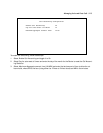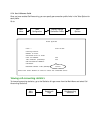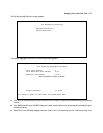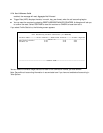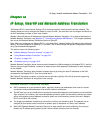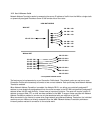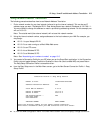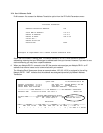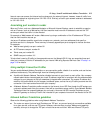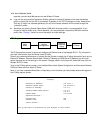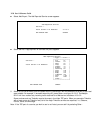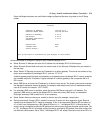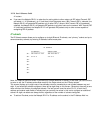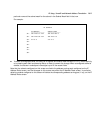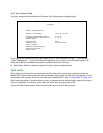IP Setup, SmartIP and Network Address Translation 10-5
Internal users can access the Internet as they always do; the external Internet, however, views all traffic from
the internal network as originating from 192.163.100.6. Similarly, all traffic your network receives is addressed
to 192.163.100.6.
Associating port numbers to nodes
When an IP client, such as a Netscape Navigator or Microsoft Internet Explorer, wants to establish a session
with an IP server, such as a Web server, the client machine must know the IP address to use and the TCP
service port where the traffic is to be directed.
For example, a Web browser will locate a Web server by using a combination of the IP address and TCP port
that the client machine has set up.
Just as an IP address specifies a particular computer on a network, ports are addresses that specify a
particular service in a computer. There are many universally agreed-upon ports assigned to various services.
For example:
■ Web servers typically use port number 80
■ All FTP servers use port number 21
■ Telnet uses port number 23
■ SNMP uses port number 161
To help direct incoming IP traffic to the appropriate server, the Netopia R2121 lets you associate these and
other port numbers to distinct IP addresses on your internal LAN using Exported Services. See “IP setup” on
page 10-6 for details.
Using multiple Connection Profiles
You can enable Network Address Translation on one connection profile, disable it on another, and use the two
profiles simultaneously. The profiles might have the following attributes:
■ A profile with Network Address Translation disabled connects to your branch or main office. Your company
network administrator has assigned you a local IP address range that is consistent with the address space
assigned to your company so that you seamlessly integrate when connected. The remote IP address and
mask for this profile define only the company’s address space, so that the only IP traffic you send over this
connection is for hosts and servers within your company.
■ A Network Address Translation profile connects to the Internet via an ISP. Even though the ISP assigns you
a dynamic address each time you connect, there will be no address space conflict, since Network Address
Translation hides the corporate address you use locally. You enter the ISP’s remote IP address as your
default IP gateway so that any IP traffic not intended for your corporate intranet will be directed to the ISP.
Network Address Translation guidelines
Observe the following guidelines when using Network Address Translation.
■ The router can export just one local IP address per TCP port, so you can have just one machine available
for a given service, such as one FTP server. However, some services, such as Web servers (www-http
servers), allow you to change the TCP port on both the server and client. With two different TCP ports



